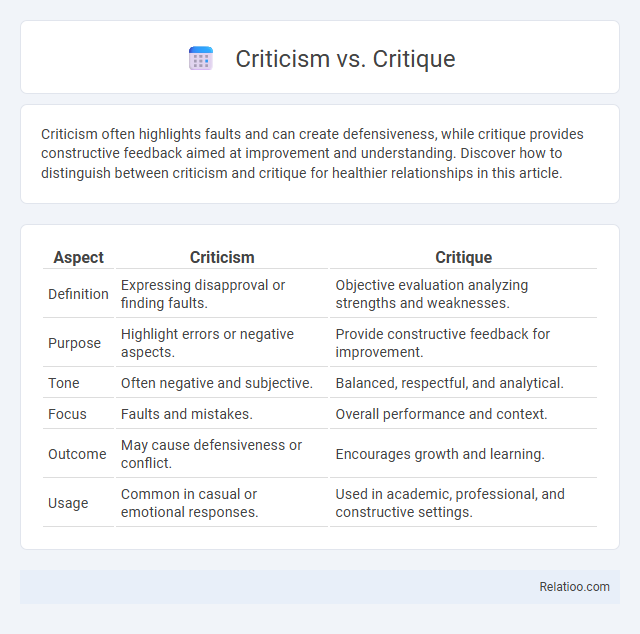Criticism often highlights faults and can create defensiveness, while critique provides constructive feedback aimed at improvement and understanding. Discover how to distinguish between criticism and critique for healthier relationships in this article.
Table of Comparison
| Aspect | Criticism | Critique |
|---|---|---|
| Definition | Expressing disapproval or finding faults. | Objective evaluation analyzing strengths and weaknesses. |
| Purpose | Highlight errors or negative aspects. | Provide constructive feedback for improvement. |
| Tone | Often negative and subjective. | Balanced, respectful, and analytical. |
| Focus | Faults and mistakes. | Overall performance and context. |
| Outcome | May cause defensiveness or conflict. | Encourages growth and learning. |
| Usage | Common in casual or emotional responses. | Used in academic, professional, and constructive settings. |
Understanding Criticism and Critique: Definitions
Criticism involves evaluating or analyzing a subject, often highlighting faults or areas for improvement, while critique offers a more balanced and detailed assessment focusing on the strengths and weaknesses of a work. Understanding criticism requires recognizing its potential negative connotations, whereas critique emphasizes constructive feedback aimed at development. Definitions of both terms underscore their roles in discourse, with criticism generally perceived as judgmental and critique as analytical and thoughtful.
Historical Origins of Criticism and Critique
Criticism and critique both trace their origins to ancient Greek philosophy, where "kritike" referred to the art of judgment and discerning evaluation, essential to rhetoric and philosophy. Historical texts reveal that criticism initially implied a more judgmental stance, often associated with identifying faults, whereas critique focused on systematic analysis and interpretation. Your understanding of these terms benefits from recognizing how their nuanced historical distinctions influence modern usage in literary, artistic, and academic contexts.
Key Differences Between Criticism and Critique
Criticism often involves evaluating something by highlighting faults or shortcomings, typically reflecting a subjective judgment that can be negative or positive. Critique, on the other hand, is a more balanced and systematic analysis aimed at understanding both strengths and weaknesses, providing constructive feedback for improvement. Your ability to distinguish between these two can enhance how you receive and give feedback in academic, professional, or creative contexts.
The Purpose of Criticism in Communication
Criticism in communication aims to evaluate and improve ideas or performances by identifying strengths and weaknesses with the intent of fostering growth and clarity. Unlike mere critique, which can be descriptive or analytical, constructive criticism emphasizes actionable feedback that promotes positive change and deeper understanding in dialogue or creative processes. The purpose of criticism is to facilitate effective communication by encouraging reflection, refinement, and progression of thoughts, expressions, or behaviors.
The Role of Critique in Personal and Professional Growth
Critique serves as a constructive process that identifies strengths and areas for improvement, fostering personal and professional development through targeted feedback. Unlike general criticism, which may be negative or vague, critique provides specific, actionable insights that promote learning and skill refinement. Engaging regularly in thoughtful critique cultivates self-awareness, resilience, and continuous enhancement of competencies in diverse fields.
Methods and Approaches: Criticism vs Critique
Criticism primarily employs evaluative methods focusing on identifying flaws or strengths, often rooted in subjective judgment and theoretical frameworks. Critique, however, utilizes analytical approaches that dissect underlying assumptions, power structures, and cultural contexts to provide deeper insight beyond mere assessment. Your understanding of these distinctions enhances the ability to apply both practices effectively in various academic or creative fields.
Constructive Feedback: Emphasizing Critique Over Criticism
Constructive feedback prioritizes critique, which offers specific, actionable insights aiming to improve Your work, unlike criticism that often highlights faults without guidance. Critique involves a balanced evaluation, combining strengths and areas for growth, fostering a positive learning environment. Emphasizing critique encourages development and motivation, making feedback more productive and supportive.
Impacts on Creativity: How Criticism and Critique Influence Innovation
Criticism often challenges Your ideas by highlighting flaws, which can either hinder creativity through discouragement or spark improvement by identifying weaknesses. Critique provides structured, constructive feedback aimed at refining innovation, fostering growth without diminishing confidence. Understanding the distinct impacts of criticism and critique enables innovators to navigate feedback effectively, promoting sustained creative development.
Real-World Examples: Criticism and Critique in Action
Criticism involves evaluating a work or behavior with an emphasis on identifying faults, exemplified by movie reviews that highlight plot weaknesses. Critique offers a balanced examination by analyzing strengths and weaknesses, such as art critiques that assess technique, theme, and emotional impact. Real-world applications include academic peer reviews where critique fosters improvement, while social media comments often lean toward criticism, impacting public perception.
Choosing the Right Approach: When to Criticize or Critique
Choosing the right approach between criticism and critique depends on the purpose and context of your analysis. Criticism often highlights faults or negative aspects, making it suitable for identifying errors or weaknesses, while critique offers a balanced evaluation that includes both strengths and areas for improvement. Understanding when to criticize or critique helps you provide constructive feedback that enhances growth and learning.

Infographic: Criticism vs Critique
 relatioo.com
relatioo.com